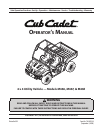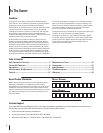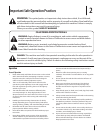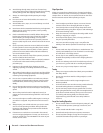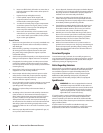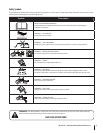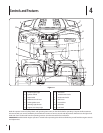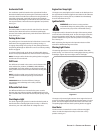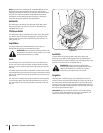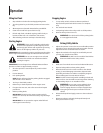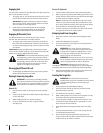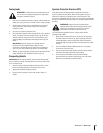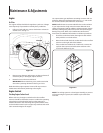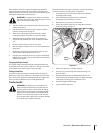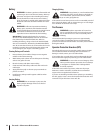
6 se c t i O n 2 — iM p O r t a n t sa f e Op e r a t i O n pr a c t i c e s
Never over fill fuel tank. Fill tank to no more than ½ h.
inch below bottom of filler neck to allow space for
fuel expansion.
Replace fuel cap and tighten securely.i.
If fuel is spilled, wipe it off the engine and j.
equipment. Move unit to another area. Wait 5
minutes before starting the engine.
To reduce fire hazards, keep engine compartment k.
and exhaust system free of grass, leaves, or other
debris build-up. Clean up oil or fuel spillage and
remove any fuel soaked debris.
Never store the machine or fuel container inside l.
where there is an open flame, spark or pilot light
as on a water heater, space heater, furnace, clothes
dryer or other gas appliances.
General Service
Never run an engine indoors or in a poorly ventilated area. 1.
Engine exhaust contains carbon monoxide, an odorless,
and deadly gas.
Before cleaning, repairing, or inspecting, make certain 2.
all moving parts have stopped. Disconnect the spark
plug wires and ground against the engine to prevent
unintended starting.
Check brake operation frequently as it is subjected to wear 3.
during normal operation. Adjust and service as required.
If equipped, the cooling system is under pressure. Never 4.
remove the radiator cap when the system is hot. Slowly
turn the cap the to the first stop to release pressure before
removing the cap.
Keep all nuts, bolts, and screws tight to be sure the 5.
equipment is in safe working condition.
Never tamper with the safety interlock system or other 6.
safety devices. Check their proper operation regularly.
Never attempt to make adjustments or repairs to the 7.
machine while the engine is running.
Do not change the engine governor settings or over-speed 8.
the engine. The governor controls the maximum safe
operating speed of the engine.
Maintain or replace safety and instruction labels, as 9.
necessary.
According to the Consumer Products Safety Commission 10.
(CPSC) and the U.S. Environmental Protection Agency
(EPA), Utility Vehicles have an Average Useful Life of seven
(7) years, or 390 hours of operation. At the end of the
Average Useful Life, have the unit inspected annually by
an authorized service dealer to ensure that all mechanical
and safety systems are working properly and not worn
excessively. Failure to do so can result in accidents, injuries
or death.
Observe proper disposal laws and regulations for gas, oil, 11.
etc. to protect the environment.
Prior to disposal, determine the proper method to dispose 12.
of waste from your local Environmental Protection Agency.
Recycling centers are established to properly dispose of
materials in an environmentally safe fashion.
Use proper containers when draining fluids. Do not use 13.
food or beverage containers that may mislead someone
into drinking from them. Properly dispose of the containers
immediately following the draining of fluids.
If applicable, escaping hydraulic fluid under pressure can 14.
penetrate the skin. If fluid is injected into the skin, seek
immediate medical attention. Do not use your hand to
check for leaks. Use a piece of cardboard or paper.
DO NOT pour oil or other fluids into the ground, down a 15.
drain or into a stream, pond, lake or other body of water.
Observe Environmental Protection Agency regulations
when disposing of oil, fuel, coolant, brake fluid, filters,
batteries, tires and other harmful waste.
We do not recommend the use of a pressure washer or 16.
garden hose to clean your unit. They may cause damage to
electrical components; spindles; pulleys; bearings; or the
engine. The use of water will result in shortened life and
reduce serviceability.
Do not modify engine
To avoid serious injury or death, do not modify engine in any
way. Tampering with the governor setting can lead to a runaway
engine and cause it to operate at unsafe speeds. Never tamper
with factory setting of engine governor.
Notice Regarding Emissions
Engines which are certified to comply with California and federal
EPA emission regulations for SORE (Small Off Road Equipment)
are certified to operate on regular unleaded gasoline, and
may include the following emission control systems: Engine
Modification (EM), Oxidizing Catalyst (OC), Secondary Air
Injection (SAI) and Three Way Catalyst (TWC) if so equipped.
Spark Arrestor
WARNING: This unit is equipped with an internal
combustion engine and should not be used on or
near any unimproved forest-covered, brushcovered
or grass-covered land unless the engine’s exhaust
system is equipped with a spark arrester meeting
applicable local or state laws (if any).
If a spark arrester is used, it should be maintained in effective
working order by the operator. In the State of California the
above is required by law (Section 4442 of the California Public
Resources Code). Other states may have similar laws. Federal laws
apply on federal lands.
A spark arrester for the muffler is available through your
nearest engine authorized service dealer or contact the service
department, P.O. Box 361131 Cleveland, Ohio 44136-0019.



